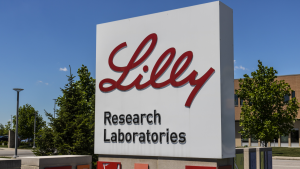Moreover, data from the S&P 500 from 1928 to the present shows that during the late-20th-century growth periods, dividends contributed significantly to the total returns of the S&P 500.
These statistics are important to remember in a tricky year, one with potentially three cuts to the benchmark federal funds rate, persistent inflation, geopolitical tensions, and the 2024 United States presidential election in November.
Amid these developments and among a sea of dividend stocks to buy with “Strong Buy” ratings, the first pick we’ll explore is an entertainment giant back on the path of recovery after legendary CEO Bob Iger is back at the helm, reinstating its dividend and refocusing on streaming. Next up, a 3-for-1 stock split from the world’s largest company by revenue broadened the investor base, but it’ll keep growing with the AI-powered initiatives on display at the 2024 Consumer Electronics Show. Finally, new business lines are opening up for a pharmaceutical company boasting 10 consecutive dividend hikes.
Dividend Stocks to Buy: Walt Disney (DIS)

Walt Disney’s (NYSE:DIS) dividend payout ratio stands at a very healthy 32%, but there is room for growth, especially under the leadership of Bob Iger, the legendary CEO of Disney, who kept his promise of reinstating the dividend by the end of 2023 after a three-year pause.
Apart from the dividend, Iger has taken multiple steps to ensure greater profitability, most notably in streaming. Both Disney+ and Hulu are growing. This includes the popularity of Disney+’s own shows and the smart buying of material like the Taylor Swift live film that is only available on Disney+.
However, Disney understands it cannot burn the candle at both ends, which is why it has strategically cut down on content spending for the last two fiscal years; $25 billion is set for 2024, down from around $27 billion in 2023.
Overall, Disney wants to cut costs by $7.5 billion by the end of fiscal year 2024, which is $2 billion more than originally planned. A reorganization is taking place that will combine organizations that provide services to both Disney Entertainment and ESPN to make business processes more cost-effective and well-coordinated.
Disney has increased its forecast for adjusted EPS this fiscal year from 20% to 25%, which is not a substantial target if the steps it’s taking pay off.
Walmart (WMT)

Walmart (NYSE:WMT) wants to build or remodel more than 150 stores over the next five years. Over the next 12 months, 650 shops in 47 states and Puerto Rico are up for remodeling.
By the end of fiscal year 2026, the ambitious retail giant hopes to automate about 65% of store services and 55% of distribution center business, reducing unit costs by about 20%.
Walmart beat estimates the last four times it reported earnings, and these initiatives build on that success. Annual revenue rose 6% to $648.1 billion for FY2024, with Walmart International’s Q4 operating income rising 397.6%, mainly thanks to Flipkart and Walmex. Walmart’s omnichannel strategy increased global online sales by 23% to $100 billion. Global advertising grew 28% to $3.4 billion, with Walmart Connect in the U.S. growing 22% in FY24. Walmart’s $2.3 billion acquisition of Vizio Holding Corp will further boost growth.
On the product side, Walmart showed off a bunch of new tech features at the 2024 Consumer Electronics Show, such as an AI-driven online search engine, an AI-powered system for automatic restocking, and virtual reality-based buying tools. Walmart is also adding more homes in the Dallas-Fort Worth area to its drone delivery service.
Eli Lilly and Company (LLY)

Eli Lilly and Company (NYSE:LLY) is on its way to Dividend Aristocrat status, with 10 consecutive dividend increases and a forward payout ratio of 27%.
It also raised its annual sales and profit projections, reflecting robustness in a post-COVID-19 environment; among dividend stocks to buy, there are few better. The updated estimate places the revenue range between $42.4 billion and $43.6 billion, following strong sales of its weight-loss medication Zepbound.
Meanwhile, LLY said that phase 3 clinical studies of tirzepatide, a drug meant to help sleep apnea, are progressing well. Compared to a placebo, the drug showed a lot more promise in improving the seriousness of the disease, potentially opening up a new business line.
On a separate note, the FDA gave Eli Lilly’s drug Jaypirca its second approval. This drug treats certain types of cancer.
Additionally, adults with moderately to severely active ulcerative colitis can now take FDA-approved Omvoh (mirikizumab-mrkz). In clinical trials, Omvoh met its main and secondary endpoints, showing that it was much more effective than a placebo at putting people into remission and keeping them there.
On the date of publication, Faizan Farooque did not have (either directly or indirectly) any positions in the securities mentioned in this article. The opinions expressed in this article are those of the writer, subject to the InvestorPlace.com Publishing Guidelines.
Faizan Farooque is a contributing author for InvestorPlace.com and numerous other financial sites. Faizan has several years of experience in analyzing the stock market and was a former data journalist at S&P Global Market Intelligence. His passion is to help the average investor make more informed decisions regarding their portfolio.
